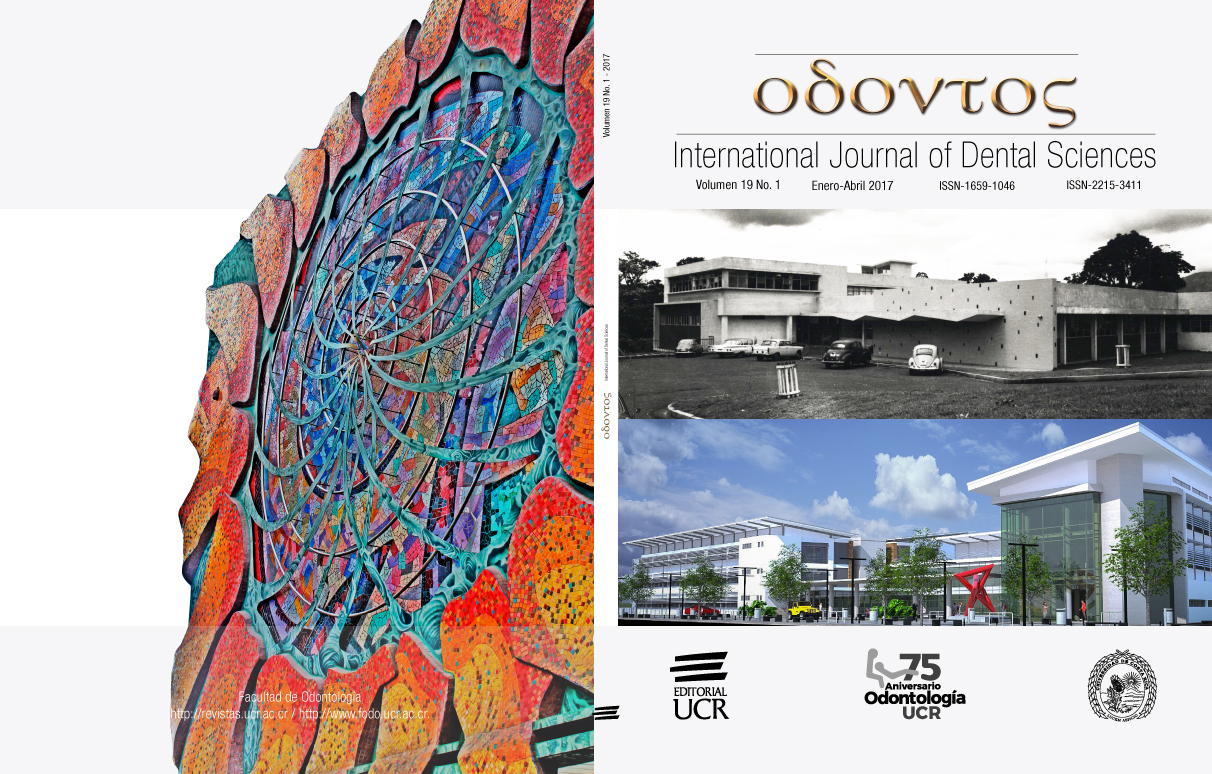Abstract
Introduction. Enamel microabrasion is a procedure used for removing a superficial layer of enamel that has some alteration of color and/or texture caused by dental fluorosis. The purpose of this study was to compare the microhardness and micromorphology of the fluorotic enamel surface after microabrasion with 6.6% hydrochloric acid and silica or 18% hydrochloric acid and evaluate the effect of desensitizing agent exposure on the treated enamel. Materials and Methods. Twenty anterior teeth with moderate fluorosis were divided into two groups: 1) Perla-Dent® group and 2) Opalustre® group. Each buccal surface of incisors was sectioned to obtain samples 3x3 mm. The samples were then mounted in acrylic blocks. The enamel surface of the blocks was polished, after the microabrasion materials and desensitizing agent were applied according to the manufacturer's instructions. All samples were analyzed by Vickers microhardness tester and scanning electron microscopy (SEM). Results. Both experimental groups presented a decrease in the microhardness values, with statistically significant differences (p<0.0001) when comparing the baseline and after treatments values. To compare the microhardness values after both microabrasion and desensitizing treatment in the study groups, it was observed that the Perla-Dent® group obtained lower values than the Opalescence® group with a statistically significant difference (p<0.0001). The representative images of study groups in SEM showed the enamel surface morphology after Perla-Dent® treatment more irregular and a very marked relief than that observed in enamel surface morphology after Opalustre® treatment. Conclusion. The surface of the enamel was more affected with Perla-Dent® treatment than with Opalustre® treatment and the placement of UltraEz® agent does not recover its baseline microhardness.
References
Fejerskov O., Larsen M., Baelum V. Dental tissue effects of fluoride. Adv Dent Res. 1994; 8 (1):15–31.
Silva-Benítez E., Zavala-Alonso V., Martinez-Castanon G., Loyola-Rodriguez J., Patiño-Marin N., Ortega-Pedrajo I., and García-Godoy F. Shear bond strength evaluation of bonded molar tubes on fluorotic molars. Angle Orthod. 2013; 83 (1): 152-57.
Bağlar S., Çolak H., Hamidi M. Evaluation of Novel Microabrasion Paste as a Dental Bleaching Material and Effects on Enamel Surface. J Esthet Restor Dent. 2015; 27 (5): 258-66.
Pini N. I., Costa R., Bertoldo C. E., Aguiar F. H., Lovadino J. R., Lima D. A. Enamel morphology after microabrasion with experimental compounds. Contemp Clin Dent. 2015; 6 (2): 170-75.
McCloskey R. J. A Technique for removal of fluorosis stains. J. Am Dent Assoc.1984; 109 (1): 63–64.
Croll T. P., Cavanaugh R. R. Enamel color modification by controlled hydrochloric acid pumice abrasion. I. technique and examples. Quintessence Int. 1986;17 (2): 81-87.
Croll T. P. Enamel microabrasion for removal of superficial dysmineralization and decalcification defects. J Am Dent Assoc.1990; 120 (4): 411–15.
Fragoso L. S., Lima D. A., de Alexandre R. S., Bertoldo C. E., Aguiar F. H., Lovadino J. R. Evaluation of physical properties of enamel after microabrasion, polishing, and storage in artificial saliva. Biomed Mater. 2011; 6 (3): 035001.
Ahmadi G., Ezoji F., Enderami S., Khafri S. Effect of Fluoride, Casein Phosphopeptide-Amorphous Calcium Phosphate and Casein Phosphopeptide-Amorphous Calcium Phosphate Fluoride on Enamel Surface Microhardness After Microabrasion: An in Vitro Study. J Dent (Tehran). 2015;12(10):705-11.
Tong L. S., Pang M. K., Mok N. Y., King N. M., Wei S. H. The effects of etching, micro‑abrasion, and bleaching on surface enamel. J Dent Res 1993; 72 (1): 67‑71.
Croll T. P. Combining resin composite bonding and enamel microabrasion. Quintessence Int 1996; 27 (10): 669-71.
Bertoldo C., Lima D., Fragoso L., Ambrosano G., Aguiar F., Lovadino J. Evaluation of the effect of different methods of microabrasion and polishing on surface roughness of dental enamel. Indian J Dent Res. 2014; 25 (3): 290-93.
Ulukapi H. Effect of different bleaching techniques on enamel surface microhardness. Quintessence Int. 2007; 38 (4): 201-5.
Lata S., Varghese N. O., Varughese J. M. Remineralization potential of fluoride and amorphous calcium phosphate-casein phospho peptide on enamel lesions: An in vitro comparative evaluation. J Conserv Dent. 2010; 13 (1): 42-46.
Meireles S. S., Andre Dde A., Leida F. L., Bocangel J. S., Demarco F. F. Surface roughness and enamel loss with two microabrasion techniques. J Contemp Dent Pract. 2009;10 (1): 58-65.
Paic M., Sener B., Schug J., Schmidlin P. R. Effects of microabrasion on substance loss, surface roughness, and colorimetric changes on enamel in vitro. Quintessence Int. 2008; 39 (6): 517-22.
Dalzell D. P., Howes R. I., Hubler P. M. Microabrasion: effect of time, number of applications, and pressure on enameloss. Pediatr Dent. 1995; 17 (3): 207-11.
Carvalho F. G., Brasil V. L., Silva Filho T. J., Carlo H. L., Santos R. L., Lima B. A. Protective effect of calcium nanophosphate and CPP-ACP agents on enamel erosion. Braz Oral Res. 2013; 27 (6): 463-70.
Tantbirojn D., Huang A., Ericson M. D., Poolthong S. Change in surface hardness of enamel by a cola drink and a CPP-ACP paste. J Dent. 2008; 36 (1): 74-79.
Jayarajan J., Janardhanam P., Jayakumar P., Deepika C. Efficacy of CPP-ACP and CPP-ACPF on enamel remineralization - an in vitro study using scanning electron microscope and DIAGNOdent. Indian J Dent Res. 2011; 22 (1): 77-82.
Rirattanapong P., Vongsavan K., Tepvichaisillapakul M. Effect of five different dental products on surface hardness of enamel exposed to chlorinated water in vitro. Southeast Asian J Trop Med Public Health. 2011; 42 (5): 1293-98.
Madhavan S., Nayak M., Shenoy A., Shetty R., Prasad K. Dentinal hypersensitivity: A comparative clinical evaluation of CPP-ACP F, sodium fluoride, propolis, and placebo. J Conserv Dent. 2012;15 (4): 315-18.

